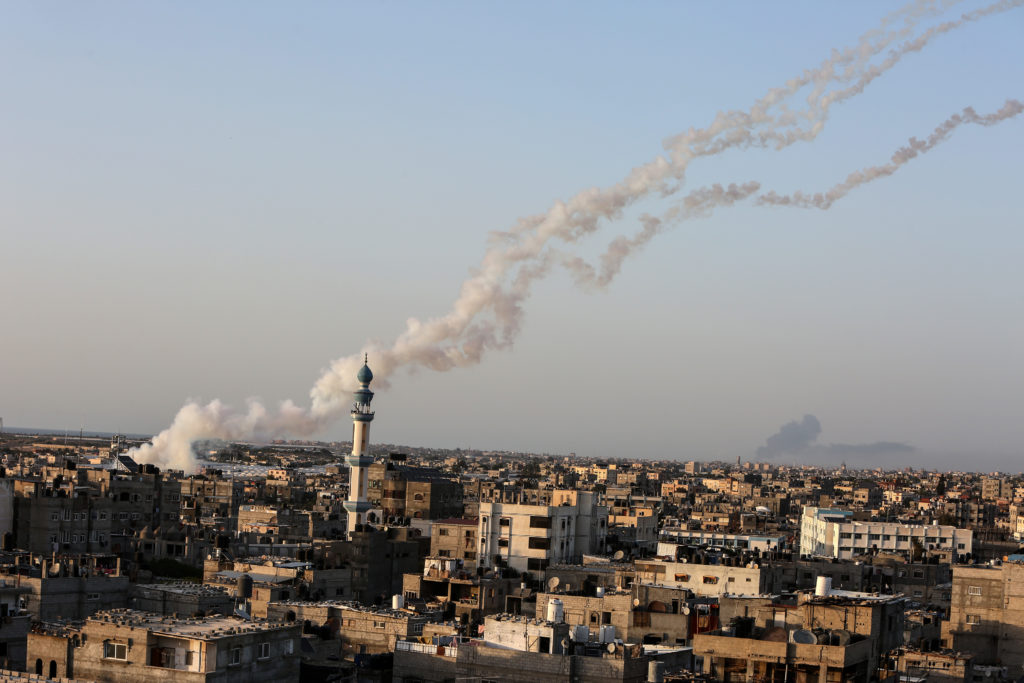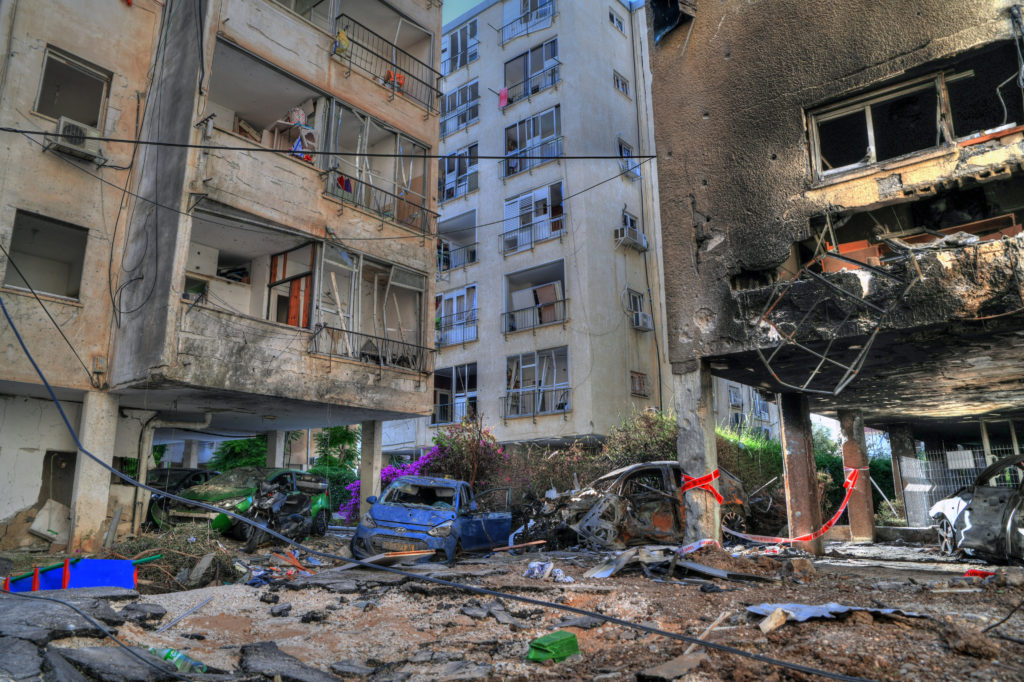Australia/Israel Review
Hamas’ War
May 28, 2021 | Amotz Asa-El

The causes and implications of the fourth Gaza conflict
It was a perfect storm. It lasted 11 days, raged across two fronts, involved four arenas of conflict and was by far the most complex, and possibly the most pivotal, of Islamist-ruled Gaza’s four military bouts with Israel.
The first front was in Gaza – which fired more than 4,000 rockets and mortars at Israel and absorbed massive airstrikes and some artillery attacks in retaliation. The second front was in Israel’s so-called mixed towns, where violence erupted among Arab and Jewish communities which have been living side by side since Israel’s inception.
Meanwhile, besides the military and the diplomatic arenas where all previous Israel-Hamas confrontations had unfolded, this conflict involved some social and political settings that were not a significant part of the previous rounds.
The military collision was sparked when Hamas fired seven missiles at Jerusalem on May 10, after giving the Israeli Government an ultimatum to evacuate its forces from parts of Jerusalem. Those missiles fell several kilometres short of the Israeli capital’s urban centre, but the casus belli was obvious – and what’s more, that first salvo was followed by a heavy bombardment of towns across southern Israel with hundreds of missiles.
Israel responded with aerial attacks on military installations and targeted killings of Hamas commanders. The following day some 100 rockets were fired at greater Tel Aviv, causing schools to close all the way up to Netanya, 30 km north of Tel Aviv, and flights to Ben-Gurion Airport to be rerouted.
Hamas ended up firing more than 4,300 rockets, missiles and mortars, of which nearly 40% were intercepted by the Iron Dome system while more than half fell either in open fields or on the Gazan side of the border. Many of the salvos targeted Ashkelon, the seaside city of 145,000 just 10 kilometres from the Strip’s northern border, and Ashdod, the port city of 225,000 halfway between Gaza and Tel Aviv.
Hamas’ rockets sent millions into bomb shelters and killed 11 civilians in Israel: eight in the south, one in Ramat Gan near Tel Aviv, and two – father and daughter Halil and Nadeen Awad – outside Lod, southeast of Tel Aviv. One Israeli soldier was killed by an anti-tank missile fired at a jeep along the Gaza border.
On the Palestinian side, Hamas lost more than 200 fighters according to the Israeli military, including six senior commanders, as Israeli jets and drones struck more than 6,000 targets throughout the 365 sq. km Gaza Strip.

Destroyed houses and cars due to a Hamas rocket attack in Petah Tikva, Israel (Credit: Shutterstock)
The IDF’s efforts to avoid civilian casualties, most notably by dropping unexploding projectiles on high-rise buildings before knocking them down, were only partially successful. Hamas’ strategy of firing from within densely populated streets resulted in several dozen civilian fatalities, including women and children, a tally for which there is no exact accepted total (despite media claims to the contrary). It is clear that some of the casualties were killed by the nearly 700 Palestinian projectiles that misfired and landed inside Gaza.
The fighting ended after both sides agreed, through Egyptian mediation, to cease firing without any preconditions or commitments. Now the question is how the fourth major round of fighting between Israel and Hamas since the latter’s takeover of Gaza in 2007 will impact the future.
From the military point of view, the main event was the IDF’s demolition of the extensive tunnel system that Hamas has built in recent years. The system, which Israeli intelligence called “the metro,” was designed to shelter Hamas fighters from bombings and to provide fortified positions from which to battle an IDF invasion.
Realising this, the IDF sent 160 jets and created a troop build-up along the border to create the impression of an unfolding ground operation. When Hamas fighters rushed to the tunnels the IDF collapsed them with special bunker-busting bombs. Meanwhile, squads from special Hamas anti-tank units who emerged from the tunnels to prepare ambushes for the IDF were attacked on the surface. It is believed that this is how Hamas sustained most of its casualties.
While Hamas sees the lost manpower as replaceable, the exposure of the tunnel system’s vulnerability means the loss of a strategic asset in which Hamas invested a fortune.
The tunnels also failed to serve Hamas as the offensive weapon they were originally meant to offer – with cross-border “attack tunnels” intended to lead terrorists directly into Israeli communities near Gaza. Not one such attack was attempted, apparently reflecting the efficiency of a system of underground walls and sensors which Israel built around the Strip.
Indeed, Hamas failed in all its efforts to diversify its offensive beyond missiles and mortars – explosive drones were quickly shot down, and an unmanned mini-submarine that was on its way to attack an Israeli destination was destroyed soon after beginning its mission.
Even so, Hamas is portraying this bout as a victory, not only because it survived 11 days of massive retaliatory fire, but because of this bout’s political dimension.
Hamas’ political assault was ignited in Ramallah and waged in Jerusalem.
In Ramallah, on April 29, Palestinian Authority President Mahmoud Abbas cancelled what would have been the West Bank’s first general election since 2005. Hamas was widely expected to emerge substantially strengthened from the election, if not win it outright.
In Jerusalem, meanwhile, thousands who flocked to the Temple Mount for Ramadan prayers clashed with police, both on the Temple Mount and around the Old City’s Damascus Gate. The pretext was an impending court decision concerning seven houses in the east Jerusalem neighbourhood of Sheikh Jarrah whose Arab tenants face eviction by Jewish property owners.
Fuming at the cancellation of the election it expected to win, Hamas used the situation in Jerusalem to issue Israel an ultimatum to remove its police from both the Temple Mount and Sheikh Jarrah. It was the sort of demand no Israeli government would even begin to consider, and therefore obviously intended as a pretext for the violence Hamas planned to unleash.
The IDF and the Shin Bet secret service had reportedly warned the Government that Hamas was preparing for a major confrontation. However, no one predicted or expected the violence would involve Israeli Arab towns and mixed Arab-Jewish ones, inside Israel. Police were therefore caught completely off guard when mobs in Jaffa, Lod and Acre attacked passers-by, vandalised parks, burnt garbage dumps, bus stations and cars, and ransacked restaurants and shops.
Worse, in the working class town of Lod, whose 77,000 inhabitants are 30% Arab, three synagogues were torched, and four more were vandalised.
Worst of all, in several locations, there were lynching attempts against Jewish residents.
The rampages spread north, to Arab towns in the Galilee, and south, to Bedouin areas in the Negev. Extremist Jewish mobs soon entered the unpoliced vacuum and began attacking innocent Arab bystanders and shops. In Bat Yam south of Tel Aviv, there was an attempt to lynch an Arab passerby.
By the third day of the riots, police began regaining control of the situation, sending hundreds of Border Police and mounted police to patrol the mixed cities, while hundreds of suspected rioters were rounded up, with the Shin Bet’s involvement. Indictments soon followed and hundreds were charged with various felonies, from arson to attempted murder.
The urban violence was quelled – but the wounds it inflicted on Arab-Jewish communal relations are expected to take years to heal.
The circumstances that produced this violence also remain to be fully explored. There had been two previous serious outbursts of Israeli Arab violence – first in 1976, in response to land confiscations in the Galilee, and then in 2000, as the Second Intifada began.
However, neither of the two precedents was nearly as widespread nor as intense as what Israel faced this time around. The possibility that Hamas actually planned the riots within Israel, perhaps even managed them together with local allies, cannot be ruled out.
Moreover, the political timing of the riots was unique not only in terms of the cancelled Palestinian elections, but also in terms of a potentially historic coalition deal which had looked about to be reached in Israel.
When Hamas touched off the fighting, Israeli politicians were reportedly some 24 hours away from signing a ground-breaking agreement that would have created a coalition government that seemed set to reboot Arab-Jewish civic relations.
Led for its first two years by the nationalist hi-tech entrepreneur and former defence minister Naftali Bennett, the coalition was to be centred on the liberal centrist Yesh Atid party. Its leader, former finance minister Yair Lapid, was to serve as foreign minister before switching jobs with Bennett to become prime minister two years later.
Besides Bennett and Lapid’s parties, another five parties were to be in this so-called “coalition of change.” This included not only the left-wing Labor and Meretz parties, but also the United Arab List (Ra’am), a pragmatic Islamic party led by dentist Mansour Abbas, whose focus is on improving life in Israeli Arab towns.
The would-be coalition’s members said their ideologically improbable grouping was meant to address the social tensions that had surfaced during Israel’s two-year-long political crisis.
The fight with Hamas brought that spirit of reconciliation to an abrupt end. “The coalition of change is no longer on the agenda,” Bennett said following consultations within his party, reasoning that such a configuration would be unsuitable for confronting the internal violence that had erupted within Israel.
Pundits suggested torpedoing the “coalition of change” may have actually been one of Hamas’ goals, because from its fundamentalist viewpoint, a spirit of reconciliation between Israel’s Arabs and Jews would have been a major setback.
Just where Israeli politics will now head is unclear. Technically, the mandate Lapid was given by President Reuven Rivlin to form a government expires on June 2. Practically, however, there appears to be no way he can form a coalition without Bennett, just as incumbent Prime Minister Binyamin Netanyahu can’t form a coalition without Mansour Abbas, an option that Netanyahu’s far-right partner, the Religious Zionism Party, flatly rejects. [Ed Note: Contrary to the expectations of most Israeli political experts, the above proved to be premature. Bennett has now unexpectedly signalled a willingness to return to his pre-war agreement with Lapid, and a new “coalition of change” government again now looks like a distinct possibility.]
Netanyahu, for his part, is reportedly still hoping to lure in another right-wing faction, New Hope, despite this party’s vow not to sit in government under Netanyahu while he is on trial for corruption charges.
At the same time, Netanyahu is trying to convince Bennett and the Likud’s satellite parties to go to a special election in which voters would directly elect a prime minister, but not a new Knesset. This idea, however, enjoys little support outside Netanyahu’s party Likud.
Once Lapid’s mandate to form government expires, the Knesset will have 21 days to try to crown a prime minister without the president’s involvement, before new elections are automatically called.
And so, the 11-day war that rained thousands of rockets on Israeli cities had hardly ended when Israel’s political cliff-hanger resumed in earnest, suggesting this stalemate is almost as permanent as Hamas’ animosity to the Jewish state.
Even so, one ray of light flickered through the mayhem, encapsulating the many dramas of recent weeks. MK Mansour Abbas appeared alongside Lod’s Mayor Yair Revivo outside one of the city’s burnt synagogues, and vowed to take part in its reconstruction, before telling all those who blocked his path to Israel’s corridors of power, from the Israeli far-Right to Hamas: “This is not Islam’s way.”
Tags: Gaza, Hamas, Israel, Palestinians






